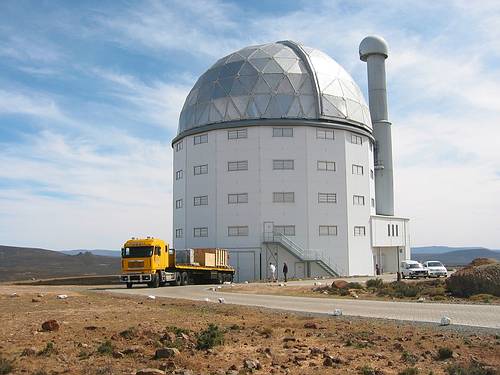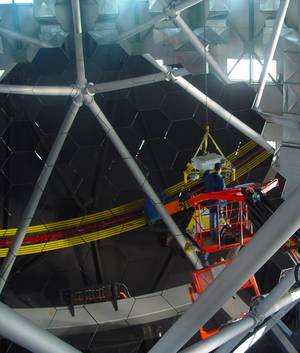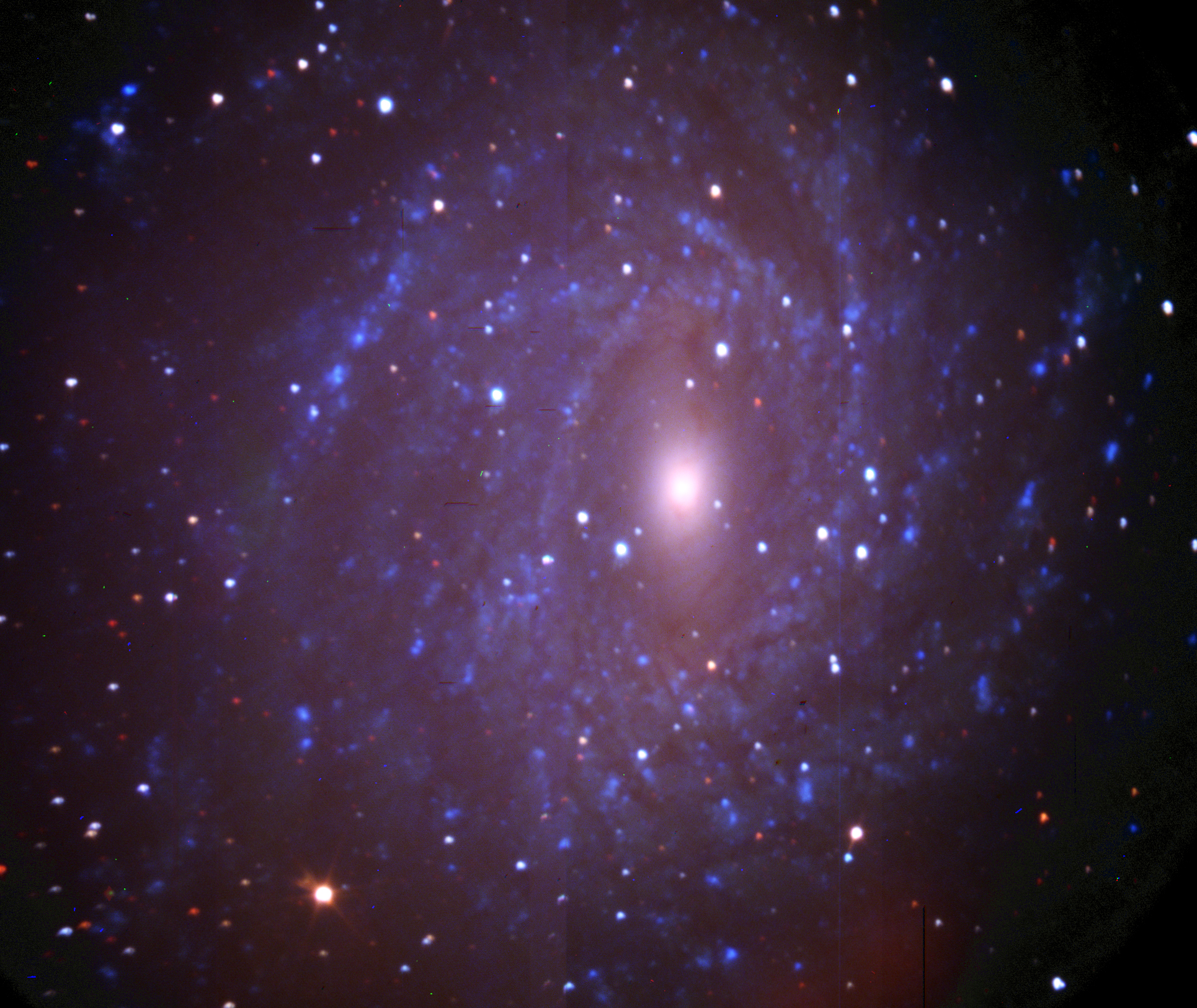Southern African Large Telescope
Interview with
Chris - I'm down here in Johannesburg, South Africa, joining you live from the southern hemisphere where scientists are putting together what could amount to a very, very powerful telescope indeed. To tell me more about it is Case Rijsdijk. He's from the South Africa Astronomical Observatory and is going to be part of SALT (the Southern African Large Telescope array). Case, what, actually is this telescope and how will it work?
 Case - Well, it's a design very similar to one built in Texas, called the Hobby Eberly telescope which we're using as a prototype. Of course, we have to accept the changes in design and so on. But it's now been completed. The ground base was in 2000, and on the 1st of September 2005 we had the first images, the first light. We've had a couple of teething problems but the telescope is functioning well. It is, of course, an enormous undertaking to build such a complex piece of machinery. Many countries didn't believe we were capable of doing it but we proved them wrong. We've actually got a better telescope than the Americans have and we've got lots of partners from all over the world to join us in this vast project.
Case - Well, it's a design very similar to one built in Texas, called the Hobby Eberly telescope which we're using as a prototype. Of course, we have to accept the changes in design and so on. But it's now been completed. The ground base was in 2000, and on the 1st of September 2005 we had the first images, the first light. We've had a couple of teething problems but the telescope is functioning well. It is, of course, an enormous undertaking to build such a complex piece of machinery. Many countries didn't believe we were capable of doing it but we proved them wrong. We've actually got a better telescope than the Americans have and we've got lots of partners from all over the world to join us in this vast project.
Chris - So when you say telescope - is this a telescope in the Isaac Newton/Galileo sense of the word or is it something different?
Case - No, it's very different. This telescope has what you call the Arecibo principle. A primary mirror stays fixed in altitude. It can rotate so we can see 70% of the sky for 20% of the cost. That makes it for us a great compromise for a developing country.
Chris - Light is focused with a mirror onto a detector. How big is that mirror?
Case - The mirror is 11 meters across.
Chris - That's huge!
 Case - That's huge and the reason why it's not the largest single telescope in the world was quite simply that we don't always use all of that surface. As the telescope is parked, pointing at the object we look at there's a tracker beam at the top that moves across and collects the light. Of course, at some stages you're not looking exactly down the middle, you're looking slightly towards the side which means you're probably looking at an 8 or 9m telescope. Worst case scenario is a 7m telescope, best case scenario about 10.5m.
Case - That's huge and the reason why it's not the largest single telescope in the world was quite simply that we don't always use all of that surface. As the telescope is parked, pointing at the object we look at there's a tracker beam at the top that moves across and collects the light. Of course, at some stages you're not looking exactly down the middle, you're looking slightly towards the side which means you're probably looking at an 8 or 9m telescope. Worst case scenario is a 7m telescope, best case scenario about 10.5m.
Chris - The published literature says you could see a candle flickering on the moons surface with this but obviously you don't want to look at the moon's surface with it. You want to do other things. What can you achieve with it?
Case - Well, because it's got nearly 80 square metres of light collecting surface which is an enormous amount you can in fact do a lot of things which take very short periods of time. You can do time series analysis, rapidly rotating binary stars it's also designed to pick up planets around distant stars. We heard about that earlier on. SALT is ideally designed to do that. With that sort of capacity it can look back very, very far into the universe.
Chris - Why do we need another ground base telescope when we've got things like the Spitzer Space Telescope looking at infrared; we've got the Hubble telescope, on its last legs admittedly, but NASA have got the James Webb planned for 2013 so why do we need a ground base? Aren't there all kinds of problems with the atmosphere corrupting the image?
Case - Yes there is. Of course, we still need the ground base telescopes to do the high- a lot of the equipment that is required to analyse the light needs to be massive. It's tonnes of stuff which you can't put in a space telescope. Quite often nowadays you'll find that telescopes like Keck and VRT in South America, now SALT as well - they will be collaborating with the space telescopes to do more detailed work. Some telescopes, not SALT, can do what we call adaptive optics where they can actually remove, physically remove, the effects of the atmosphere. So for example VRT is South America is producing better images that Hubble even though it is on Earth. These are problems that develop in technology.
 |
| NGC 6744 Galaxy © SALT Foundation |
Chris - Is it fully functional or is there still a sort of work-up going on to get it up to scratch?
Case - We have found that there needs to be a substantial overlap between engineering and science. In America they stop the engineering, started the science and have had problems. We've tried to avoid that and we've got sort of a much longer lead-in chance of doing science. It is doing science, it's producing science and it's already produced some really good results.
Chris - I've got an email here which is from Johann Marsu. He says, 'I love this show, I listen to it while I'm in my cell culture hood,' so I'm guessing he's a cell biologist, 'I've got a question about the Big Bang. Recently I was told we could see the light from the Big Bang. How is this possible? Wouldn't the light from billions of years ago (given the universe is about 13+ billion years old) be absorbed and scattered all over the place by now?'
Case - No. It is possible to look back quite a long way but you cannot look back to the Big Bang. The universe was opaque. It was transparent to neutrinos but not to light. That only came at best 300,000 years after the Big Bang. At present we could probably look back about a billion years and do science there.
Chris - So why is that light still visible? What he's asking is, why hasn't the light become so spread out that we just can't see it?
Case - Well it's - I don't know. We can look back to a supernova with huge red shifts but the light has not been scattered or dispersed. This is a paper by Joe Silk. You can see the supernovae for a very long way back.
- Previous An Alien Solar System
- Next Living in space









Comments
Add a comment